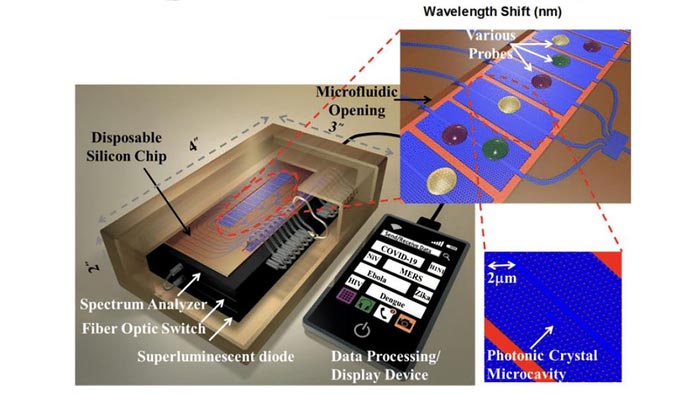Optical techniques offer fast, efficient COVID-19 detection

A sample optical detection platform for rapid COVID-19 diagnosis.
Credit: Asghari et al.
Without rapid point-of-care testing, the pandemic will likely continue to evolve.
Without the prospect of herd immunity on the immediate horizon, speedy detection for COVID-19 remains imperative for helping to curb the pandemic. Point-of-care testing that can provide immediate results is an urgent need.
Researchers from the University of Texas at Austin and Omega Optics Inc. investigated the opportunities and challenges in developing rapid COVID-19 sensing techniques. They discuss the prospects of optical biosensors for point-of-care COVID-19 testing in the journal Applied Physics Reviews, from AIP Publishing.
“Due to growing cases resulting from more transmissible variants around the world and the need to prevent and control cases and outbreaks when they arise, we should be utilizing rapid testing more commonly to detect and stop the spread before hitting the transmission peak,” said Aref Asghari, one of the authors.
One of the most promising solutions to accurate rapid testing is using optical biosensors. When a virion is present on the surface of an optical sensor, its interaction with a light beam on the sensor affects the light’s properties, causing a measurable shift in the light signal. Even with only a very small viral dosage, the system can reliably detect the coronavirus in real time.
“In case of COVID-19, the viral load at the onset of infection can be low enough to not be detected by many commercially available methods,” Asghari said. “Therefore, viral detection, especially at earlier infection stage, can be very challenging.”
There are a number of different ways in which this interaction can be utilized and improved upon, such as integrating it with measurements of plasma oscillations or incorporating graphene into its fabrication process.
Each potential configuration uses a different mechanism to sense the virus and has its own set of advantages and drawbacks, but the primary takeaway remains the same. Even with the widespread availability of vaccines, the pandemic cannot be overcome without developing faster ways to determine infection, particularly as mutations and new variants of the virus continue to arise.
“The combination of vaccines and rapid tests will drive down community transmission to a point where we can effectively eliminate the virus,” Asghari said.
The article “Fast accurate point of care COVID-19 pandemic diagnosis enabled through advanced lab-on-a-chip optical biosensors: Opportunities and challenges” is authored by Aref Asghari, Chao Wang, Kyoung Min Yoo, Ali Rostamian, Xiaochuan Xu, Jong-Dug Shin, Hamed Dalir, and Ray T. Chen. The article appears in Applied Physics Reviews on Sept. 7, 2021 (DOI: 10.1063/5.0022211) and can be accessed at https://doi.org/10.1063/5.0022211.
ABOUT THE JOURNAL
Applied Physics Reviews features articles on significant and current topics in experimental or theoretical research in applied physics, or in applications of physics to other branches of science and engineering. The journal publishes both original research on pioneering studies of broad interest to the applied physics community, and reviews on established or emerging areas of applied physics. See https://aip.scitation.org/journal/are.
Journal: Applied Physics Reviews
DOI: 10.1063/5.0022211
Article Title: Fast accurate point of care COVID-19 pandemic diagnosis enabled through advanced lab-on-a-chip optical biosensors: Opportunities and challenges
Article Publication Date: 7-Sep-2021
Media Contact
Larry Frum
American Institute of Physics
media@aip.org
Office: 301-209-3090
All latest news from the category: Physics and Astronomy
This area deals with the fundamental laws and building blocks of nature and how they interact, the properties and the behavior of matter, and research into space and time and their structures.
innovations-report provides in-depth reports and articles on subjects such as astrophysics, laser technologies, nuclear, quantum, particle and solid-state physics, nanotechnologies, planetary research and findings (Mars, Venus) and developments related to the Hubble Telescope.
Newest articles

Innovative 3D printed scaffolds offer new hope for bone healing
Researchers at the Institute for Bioengineering of Catalonia have developed novel 3D printed PLA-CaP scaffolds that promote blood vessel formation, ensuring better healing and regeneration of bone tissue. Bone is…

The surprising role of gut infection in Alzheimer’s disease
ASU- and Banner Alzheimer’s Institute-led study implicates link between a common virus and the disease, which travels from the gut to the brain and may be a target for antiviral…

Molecular gardening: New enzymes discovered for protein modification pruning
How deubiquitinases USP53 and USP54 cleave long polyubiquitin chains and how the former is linked to liver disease in children. Deubiquitinases (DUBs) are enzymes used by cells to trim protein…


